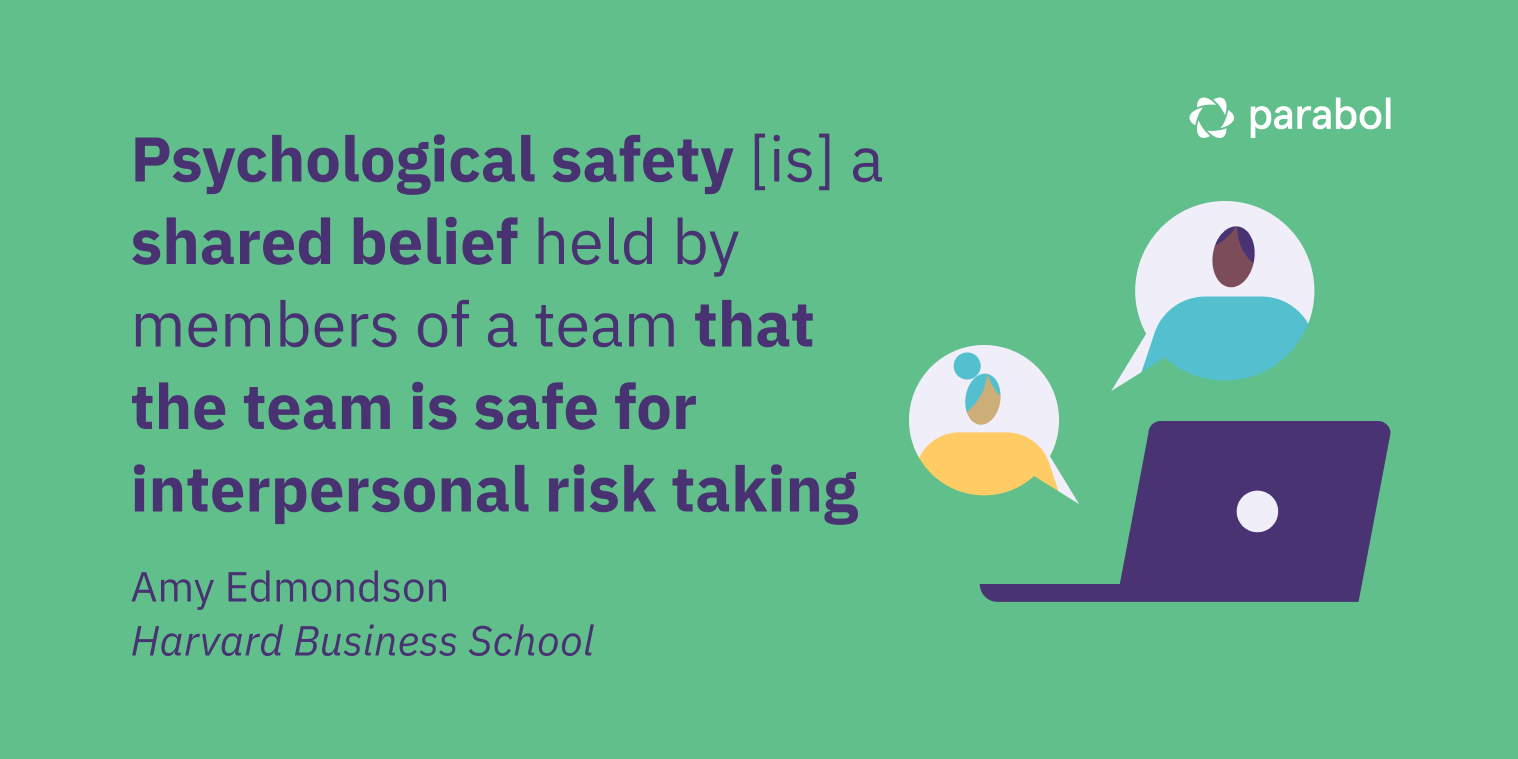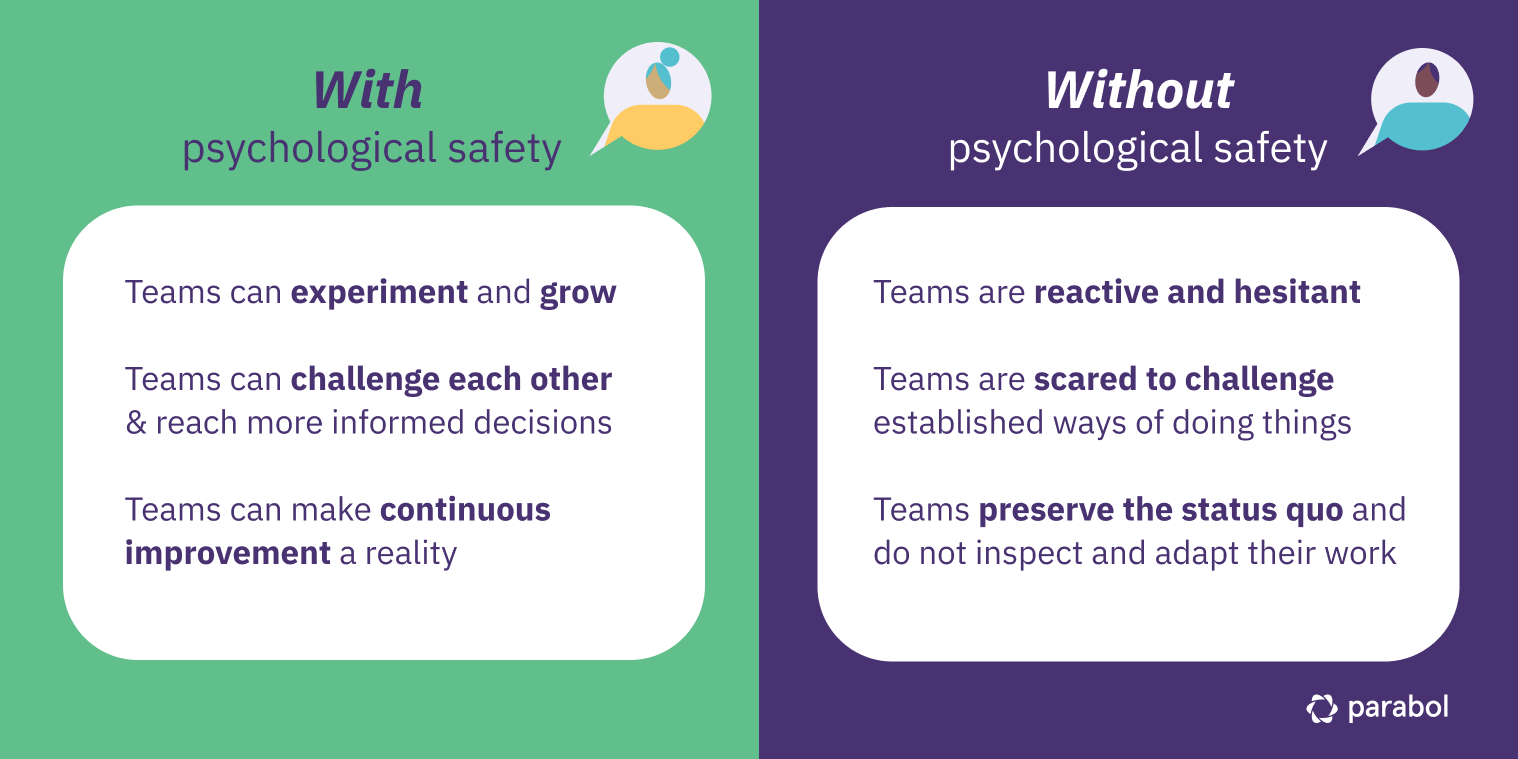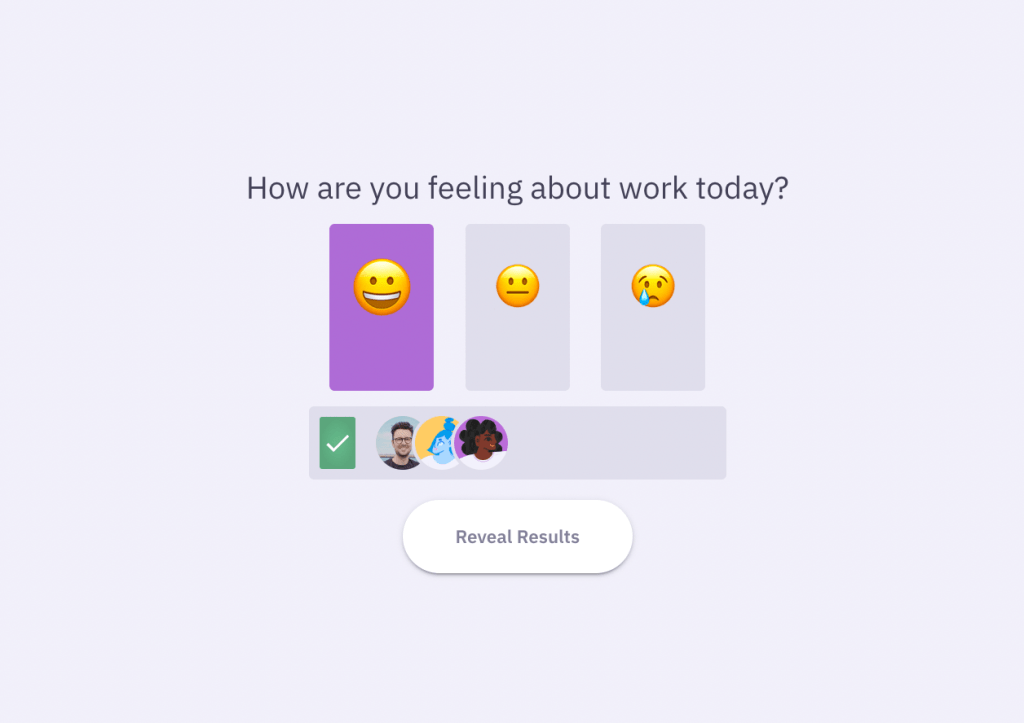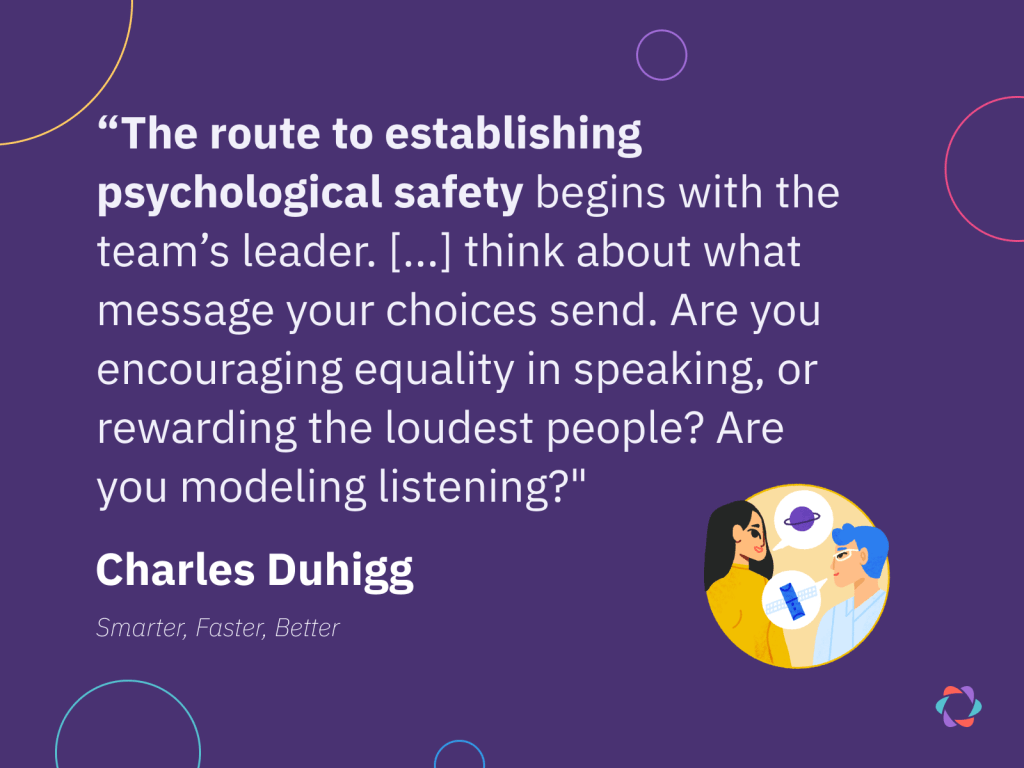How to Build Psychological Safety in Remote Teams

Psychological safety is critical for team cohesion, honest feedback, and employee wellbeing. But remote work makes it much harder to achieve. Despite the freedoms of remote work, it’s much more difficult to create psychologically safe spaces because you lose out on the physical environment of an office where it’s easier to build connections and get a sense of team dynamics.
In this guide, we’re covering what psychological safety is, why it matters, and how to build it for your remote team.
This article is split into the following sections:
What is Psychological Safety?
Harvard Business School’s Amy C. Edmondson first coined the phrase psychological safety back in 1999. People have interpreted the definition differently over time, but broadly speaking, psychological safety is the ability to bring up genuine opinions, ask questions, or own up to mistakes at work without risking being ostracized, damaging your social capital, or being punished.

Professor Timothy R. Clark has expanded on Amy Edmondson’s work by putting together four stages of psychological safety:
- Inclusion safety: Team members feel that they belong to the group and are included as a valued member of a social unit.
- Learner safety: Team members feel safe asking questions, recognizing where they can improve, making mistakes, and giving and receiving feedback.
- Contributor safety: Team members feel confident contributing their skills, abilities and opinions, and are empowered to do so.
- Challenger safety: Team members have no problem challenging the status quo and asking probing questions such as “Why do we do it this way?” or “What is we try it this way instead?”
Psychological safety also now explicitly includes feeling you are given the same ‘safe’ treatment regardless of your identity.
The definition expands once again with remote teams. While the fundamental premise is the same, remote and distributed teams must also consider how people existing in different physical environments or different cultural norms affect psychological safety.
The Business Value of Psychological Safety
Those who challenge the importance of psychological safety often assume that it’s helpful on a person to person basis, but largely irrelevant on an organizational level.
It’s easy to see why this thought might come about. Psychological safety is the first step in a larger process from psychological safety to risk-taking and idea generation, meaning it can feel very disconnected from a business’ goal outcome of productivity, growth, and profits.
However, it is critically important, because psychological safety is the prerequisite of risk-taking, creativity, and metaphorically sticking your neck out for others (or for bold ideas), according to Harvard Business Review.
Psychological safety allows team members to bring their whole self to work in a safe environment for interpersonal risk-taking where team learning is encouraged.

When a team is willing to take risks and stick their necks out for each other, they create networks of dependability and trust. From there, a team can assign duties without ego and plan projects focused on outcomes, not politicking. When teams make a concerted effort to build psychological safety, they set the business up for success.
While it’s tough to draw a causal line from psychological safety to profits, research indicates that without psychological safety, profits will be short-lived (if they come at all). It makes sense when you think about it. If team members can build trust, and take risks, they can also innovate, practice teamwork and show radical candor, without fear of reprisal.
Psychological Safety Assessment Questions
It’s easy to tell when you don’t have psychological safety – because nothing gets done, everyone is stressed and people fear speaking up. But it’s harder to tell when it is present – or to what extent.
One way team leaders can assess if they have psychological safety on their teams is through observational questioning.
Try asking these questions to check if you have psychological safety on your team:
- Do people regularly admit if they don’t know something and ask for help?
- Do people occasionally (or regularly) challenge entrenched ways of doing things if they feel another approach would better serve a goal?
- Are all team members contributing regularly in discussions?
- Are “quieter” team members directly asked for their opinions and contributions?
- Do team members know each other outside of work (even at a high level)?
- Do people speak openly (and happily) about the company’s culture and values?
If you’re able to say “yes” to all of these questions, chances are you have a good level of psychological safety on your team.
That’s not to say this list is exhaustive, just that it’s a gut check. If your answer to some or all of these questions is “no”, then you may have room for improvement.
Another way to identify a lack of psychological safety is to think about what negative actions people may be taking:
- Do people shy away from admitting they don’t know something or shy away from asking questions?
- Are there “quiet” people that never get asked for their opinion and “talkative” ones that dominate every meeting?
- Do people eye-roll or talk about values in a mocking way?
- Do people distance themselves from mistakes and look for someone or something to blame?
It’s tempting to think of these issues as being to do with employee behavior, but they’re usually a good indicator of employee engagement.
If your employees are suffering from disengagement, chances are team performance and team effectiveness is suffering as a whole.
Mindsets that Improve Psychological Safety
The first step towards cultivating psychological safety is actually wanting it. That may require individual contributors and leaders to shift their mindsets. The “right mindset” isn’t necessarily defined by a way of thinking, but based on what you want to see from others.
Here are some ways your mindset might need to change.
Mindsets that apply to everyone
🌲 ️ Output orientation: First, everyone needs to focus on what the team is trying to achieve. Second, think about how your contributions fit into that output. This isn’t about ranking inputs by order of importance – it’s about focusing on producing the goal outcome together.
😊 Assume positive intent: When communicating remotely it’s easy for misunderstandings to happen. Everyone needs to come to the table assuming everyone else has the best possible intentions and is working towards the same ultimate goal.
❓ Value curiosity: Asking questions should always be seen as a way to deepen understanding. By the same token, asking questions should never be weaponized or used to derail something you don’t like. Questions land better when there’s a shared belief in seeking to understand before being understood. This simple practice creates a psychologically safe workplace where people know they will be heard, rather than shouted over.
️🦄 Choose diversity: If you want creative problem-solving, you need a team with unique and different experiences. You never know which experience or thought will help produce the best outcome, so you should always choose diversity. Research even shows that diverse teams are smarter. Diverse teams should be empowered to freely speak up and own their perspectives without fear of reprisal or loss of social capital.
👤 Self-awareness: Everyone needs to know what they are good at (and own it). That includes the outcomes of your work. On the flip side, know what your weaknesses are. And know that everyone else has strengths and weaknesses just like you do.
Leadership mindsets
👑 Champion your people: If you’re going to be honest and upfront with criticism, you need to match it with honest and forthcoming praise and recognition.
👋 Work in public: Discussing important pieces of work or exchanging information in direct message chats breeds secrecy and a feeling that people are left out of the loop. Work in public channels as often as you can so everyone feels involved.
✅ Include your team in decision making: Ask for opinions and input. It’s all part of getting the best outcome and respecting that people should have some say in how they are governed. This doesn’t mean you must appease everyone, but it means you’ll have the best and most diverse available information with which to make your decision.
Individual contributor mindsets
⏰ Embrace ritual and routine: When you don’t have a physical office environment, the ongoing beat of certain meetings or rituals can become a base for culture. One way psychological safety breaks down is when the team has nothing to “lean” on. In an office environment, showing up at the office can be the routine people “lean” on. In a remote environment, ritual and routine help to fill the gap left by not having a shared physical space.
🚧 Set work boundaries: You can’t be creative and “on” all the time – it won’t work. Research shows that putting in the extra hours is… pointless. You need to be able to remove yourself from your work on a regular basis, both for personal recuperation but also to gain perspective on your work.
Activities and Actions to Improve Psychological Safety
Cultivating psychological safety requires a mindset to start, but actions to grow. Team meetings and 1:1 meetings are prime opportunities to cultivate psychological safety throughout the whole team.
Outside of those meetings, there are a lot of ongoing actions you can take as a leader. It might be that you need to make some organizational changes to help employees reach their goals and build high performance into your team’s DNA.
Team meeting activities
☕ Icebreakers: Start meetings with a game. Parabol has a weekly ‘Fika’ to spend social time together where we don’t talk about work. Since you’re not working side by side, it can be more difficult to sense your colleagues’ moods or emotional contexts. So use an icebreaker to get a better read on your colleagues and to reveal some fun facts about each other.
🦸 Lead by example: Step up and admit when you don’t know something. Own a mistake. Intentionally ask someone for their perspective.
💬 Encourage healthy conflict: Make it clear that disagreeing is okay and encourage people to flesh out their concerns if they show any doubt or confusion.
✏️ Share incomplete work: Ideas evolve over time. You don’t have to wait until something is done to share it and get feedback. Sharing early and often makes work feel like more of a team effort, removes ego, and helps teams iterate better.
📌 Leveraging interactive features in virtual meetings: Most video chat apps have hand raising, polls, other other interactive features like reacting with emojis. Encourage team members to use them when they want to speak or can’t get a word in.
📊 Poll team health: Ask your team how they are feeling about work at the start of your meeting. Parabol has a team health tool to help you do just this.

1:1 meeting activities
✍️ Be intentional about feedback: Praise things that are going well, be honest about things that aren’t. Approach these meetings with an outcome focus so you can talk about how something isn’t helping an outcome, versus making it about the person.
🪙 Follow the platinum rule: The golden rule is to treat people as you want to be treated. The platinum rule is to treat people as they want to be treated. If you’re gregarious and someone else is quiet, do your best to engage more quietly and calmly. On the flip side, hopefully that person is working on being more upfront and talkative when they approach you!
General actions to cultivate psychological safety
🧠 Embed psychological safety into hiring and performance management: Give everyone a chance to say their piece, defend themselves if necessary, and be upfront when something isn’t working. At Parabol, we do a “batting practice” at the end of our remote hiring process to test for mutual comfort and fit. That way, when new folks join the team they already know what to expect and have a foundation of psychological safety to build on.
♻️ Hold regular retrospectives: Incremental improvements over time will help you immensely. Don’t shy away from running sprint retrospectives on your team (even if you don’t use agile elsewhere). All teams can benefit from taking a look at what’s working and what’s not. Perhaps try running a retrospective on where psychological safety is high and low to find easy opportunities for improvement.
👂 Practice active listening: Do one thing at a time. No phones during meetings. No side chats. Give team members your full attention and show respect for their opinions.
🤗 Talk more personally: Ask about people’s lives and opinions, not just their work. One question we like to ask is: “How does it feel to be you right now?”
🧠 Effectiveness, not efficiency: Think about what actually works and do that. Don’t do something just because it’s fast. Psychological safety comes from an individual feeling valued. If they are only ever told to rush through, they can’t focus on doing things properly or to the best of their abilities. That compounds over time to people feeling like their company doesn’t care about them.
🌐 Create a communications framework: Make it clear that certain types of communication go in certain formats. This helps limit “communication anxiety” as one remote entrepreneur calls it. For example: let’s say you keep everything in a general team channel in Slack including urgent messages, memes, team updates, etc. If a team member sees a notification in that channel, they have no idea whether it’s a fun meme or a code-red emergency. That causes anxiety. Instead, have clarity on which channel is for what kind of communication. The meme channel lights up? It can wait. The emergency channel lights up? All hands on deck.
How to Refine and Build Psychological Safety Over Time
Psychological safety can feel like a weird, touchy-feely subject, and in some ways it is. And that can make it hard to measure.
However, it’s relatively easy to know when you have it versus when you don’t.
Focus on first identifying if you have psychological safety on your team using the questions in this guide. If not, that should be your only goal.
Then, focus on one thing: incremental improvements. It doesn’t need to be a big bang effort. In fact, it probably shouldn’t be. Trying to fix every problem at once is likely to create a lot of tension and anxiety. Take small steps towards your goal and reflect on how it’s going every month or quarter using a retrospective.
Building psychological safety is the foundation of team success. Improving on it week in, week out, helps make your team more adaptable, resilient, and human.
Without psychological safety, teams hide issues, work in fear, and treat each other with suspicion.
Those teams set themselves for failure. Don’t be like them. Work on building your team’s psychological safety to set your team up for success.
Psychological Safety FAQs
We’ve answered some of the most common questions about psychological safety for you.
Why Is Psychological Safety A Crucial Component Of A Culture Of Safety?
Psychological safety is just one component in an overall company culture of safety. Safety at work comprises both psychological and physical safety. Psychological safety is a crucial component of a culture of safety because without it people are not able to speak their minds, admit to failure, or even feel safe reporting abusive behavior at work, such as bullying or harassment.
According to Dr. Amy Edmondson, what is psychological safety?
Amy C. Edmondson is the Harvard professor who first coined the term psychological safety in a paper in 1999. According to Dr. Amy Edmondson, psychological safety is “the belief that one will not be punished or humiliated for speaking up with ideas, questions, concerns or mistakes.”
Amy Edmondson has also said the following things about psychological safety:
- “Team psychological safety is defined as a shared belief that the team is safe for interpersonal risk taking” – Amy C. Edmondson
- “Psychological safety is not about being nice or lowering performance standards, it’s about giving candid feedback, openly admitting mistakes, and learning from them.” – Amy C. Edmondson
👋 See more here: 41 Psychological Safety Quotes + Directives
For creating psychological safety, what is the most powerful action a leader can do?

Psychological safety is not created overnight or by individual actions. It is created through repetitive and consistent actions that allow people to feel safe opening up. The most power action a leader can do to create psychological safety is model psychologically safe behavior for others. When a leader models those behaviors – not getting defensive, admitting failure, sharing learnings openly – the rest of the team often feels safe to do the same thing.
Here’s a great psychological safety quote by Charles Duhigg on this phenomenon:
- “In general, the route to establishing psychological safety begins with the team’s leader. So if you are leading a team—be it a group of coworkers or a sports team, a church gathering, or your family dinner table—think about what message your choices send. Are you encouraging equality in speaking, or rewarding the loudest people? Are you modeling listening?” – Charles Duhigg








